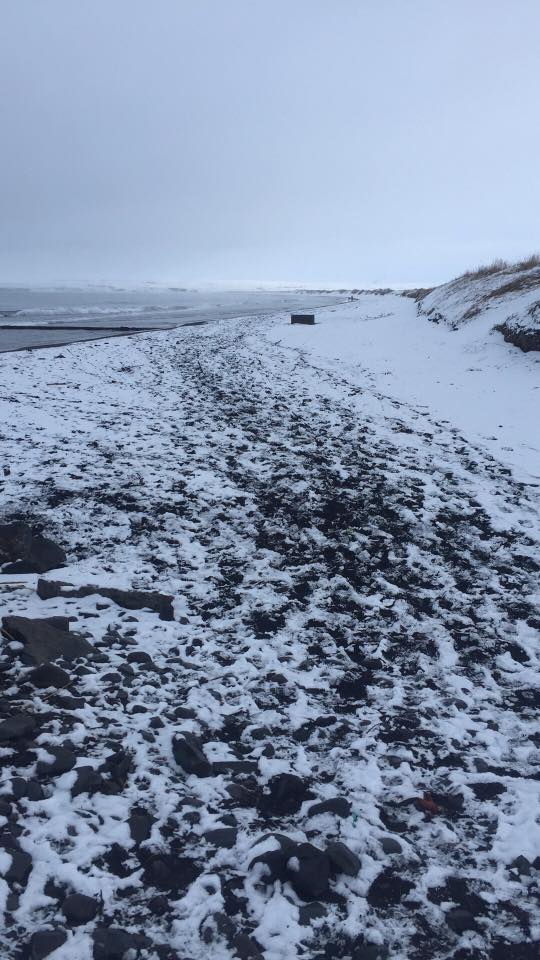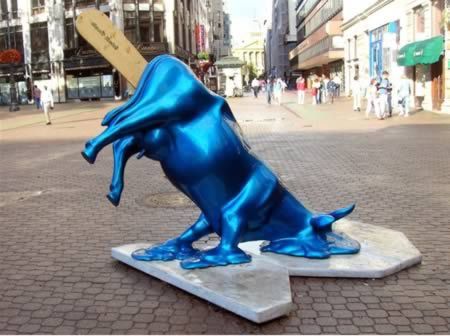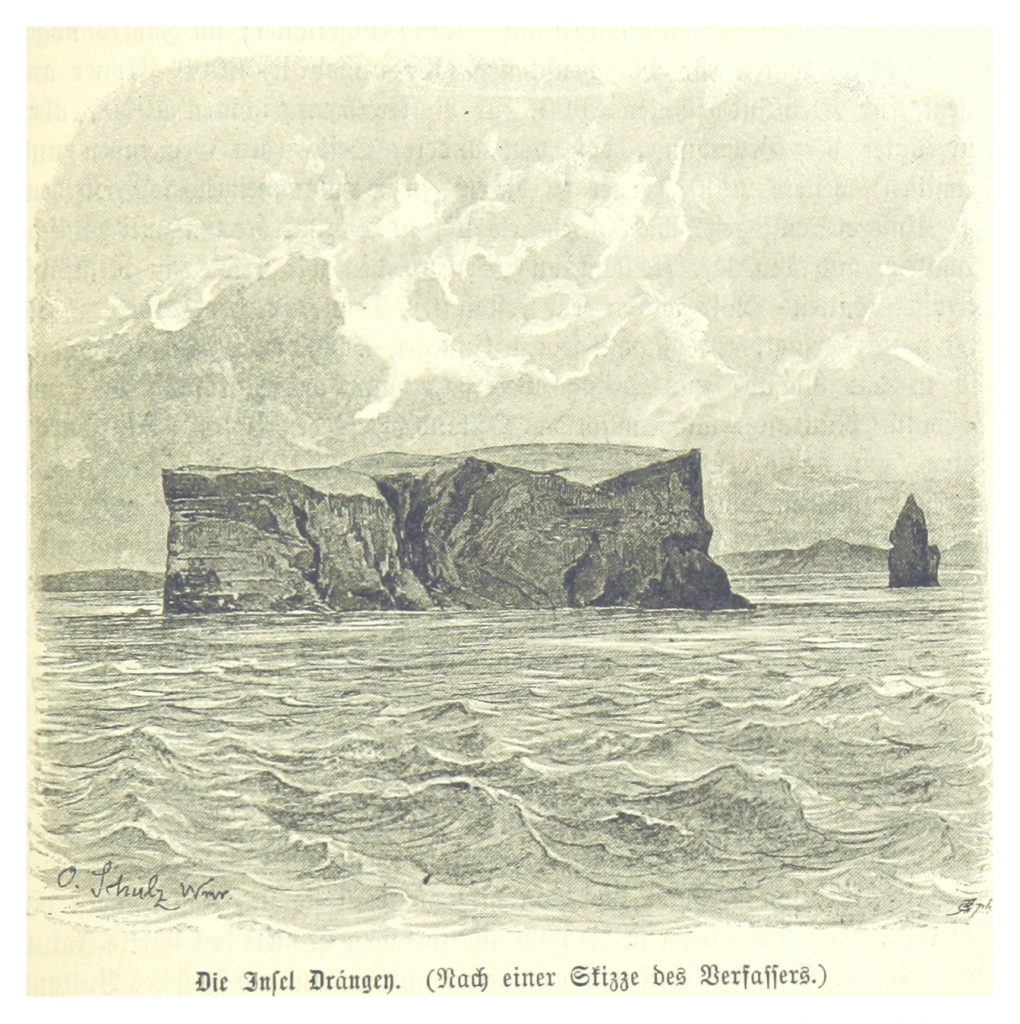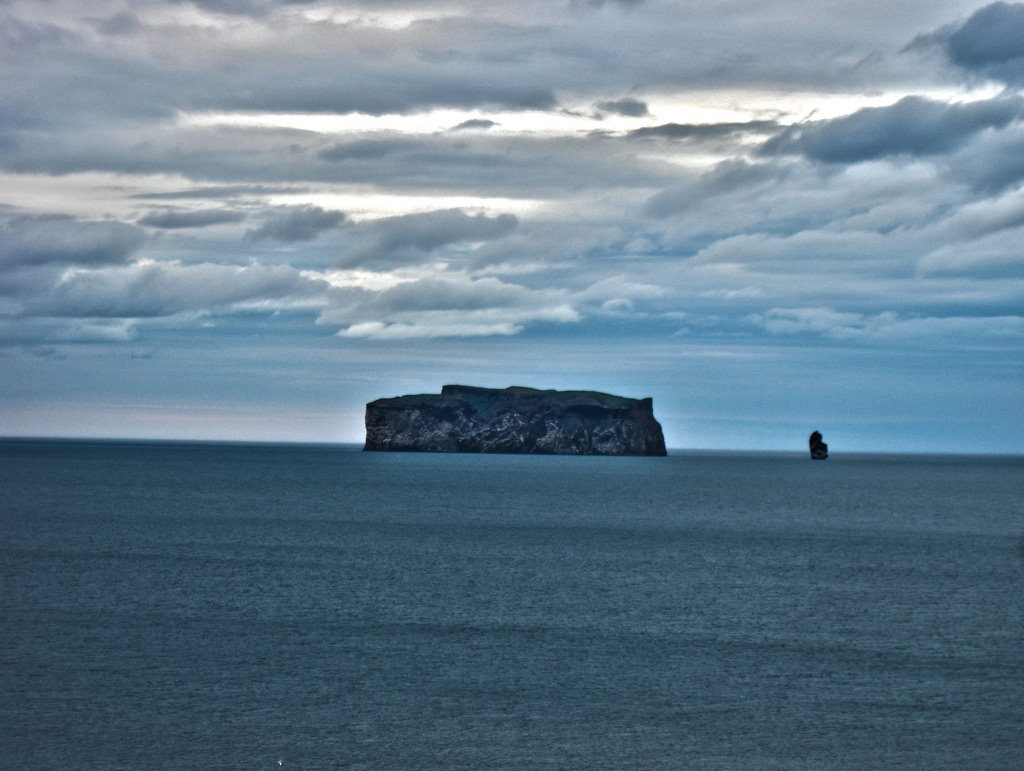A Gray and Hairy Handful of Stories About Drangey, While on Haitus in the North Of Iceland Posted by Meg on Feb 20, 2017 in Icelandic culture, Uncategorized
Yesterday, I headed up to Sauðárkrókur, the biggest small-town in all of Iceland, with a population of around 2,000. I came here because I’ve found that I’m at my best after a respite from work – or, rather, I find that I work best when I am away from home to work. The quiet up here is what Gyrðir Elíasson calls “steinnþögull” (well, he uses it as a verb – steinþagna), meaning stone-silence. That’s probably not unrelated to the idea of “steinsvefn” or “stone-sleep” – much like we say (in U.S. slang), “asleep like a log”.
So I took a walk to the beach today, which was covered in snow, and I thought about what I might write. This is my first time in the north of Iceland. So I gathered up a book of Icelandic folktales (because, honestly, who doesn’t love a good ghost story?) and I chose to take a look at those that took place nearest to me. Drangey (Drangi (M) = a pillar of rock; ey = island) seemed to be the place.

But first, a little bit about the island itself:
Drangey is the remnant of a 700,000 year-old volcano (about 6km offshore), worn away by the constant lapping of the ocean. It’s about 168 meters tall, with sharp cliffs, and a flat top. Though it’s a mixture of basalt and tuff (solidified debris from an eruption), years and years of erosion have transformed those rocks into soil nutritious enough to cultivate life. It’s got grassy flower fields and is a known hub for seabirds (guillemot, auk, puffin). But it’s a lateral climb (now, luckily, there’s a ladder), and not for the faint of heart.
Which makes it the ideal hangout for an outlaw.
In Icelandic folklore, the island is said to be a petrified troll-cow. Sort of like this melted cow sculpture in Budapest, but like all things Icelandic, made of basalt:

One evening, a lovely troll couple went traveling with their sow to introduce it to a fine looking young bull, who just happened to be all the way west in Strandir. They’d hardly made any headway when the sun rose, mineralizing the trio. The troll-wife became the rock-pillar known as Kerling (Old Woman – but don’t go around using this word, it’s not really polite), the troll-husband, became Karl (Man, or Old Man). Karl was just north of the island and Kerling is just south; Karl collapsed into the sea in 1755.
Now, that said, Drangey was first mentioned in Grettissaga. Grettir (a well-known outlaw) took refuge there for the last three years of his life, fleeing from various enemies. (As aforementioned, it’s prime real-estate for a man on the run.) Because Grettir was afraid of the dark after his wrestling match with the ghost Glámr (he’s a corporeal ghost), he brings along his brother and his slave for company. The saga says that he swam to shore to fetch firewood when they’d run out, and he brought the wood back (burning?) to the island (we won’t go into the specifics of how he got the wood, or what he did while he was on land).
The swim itself has been repeated at least 15 times since the 70s (strangely enough, I recently met the first Icelandic woman to swim across the English Channel – more on that later).

And, now, the last story I want to tell is about Guðmundur Arason, the 13th century bishop of Hólar, and the devil. He was lauded for helping those in need, and ultimately earned the name Gvendur the Good (Gvendur is a diminutive of Guðmundur – guð is pronounced “gvouthe”). He was renowned for blessing and consecrating various places across Iceland, especially wells, many of which now have his name attached to them (Gvendurbrunnar).
Since (and before) Guðmundur’s time, the lives of many a forager have been lost in pursuit of the precious eggs of birds nesting on the island. Long ago, people began to feel there was something suspicious in the number of accidents on the cliffs. Upon closer inspection, it was discovered that the climbing ropes had been cut/severed by a sharp impliment – maybe an axe or a knife.
So bishop Gvendur decided to lend a hand by blessing the cliffs, in the belief that the evil spirit(s) dwelling there would be banished. He made his way to the island with his clergymen. They sang mass at a rock shelf (henceforth known as Gvendur’s altar, where people still say prayers). While the bishop was in the process of blessing nesting grounds on the north-western end of the island, while dangling from a rope, mind you, a “hairy gray hand” (hönd ein grá og loðin) emerged from the rock face, brandishing a sword. It began to saw away at the rope.
Now this is where it gets interesting. Gvendur doesn’t make a deal with the devil per-say. (The gray and hairy hand is how the devil’s hand is described in Icelandic folklore, with relative frequency). Instead, the hand saws away at two of the three main strands of his rope, but can’t cut the third because Gvendur did such a top-notch job of consecrating that single strand. So while Gvendur is hanging by a thread, the devil, who has clearly been killing off the local bird-poacher/egg-gatherer population, says to him, “Vígðu nú ekki meira, Gvendur biskup; einhverstaðar verða vondir að vera.” (Roughly, “Bless no more, bishop Gvendur; evil also needs place to dwell.”).
So he did just that. His clergymen pulled him back up the cliff, leaving that section of the cliffs unconsecrated. It’s now called (unsurprisingly?) Heiðnaberg (heathen’s cliff), where there are supposedly more birds than anywhere else on the island.

Til next time –
M

Build vocabulary, practice pronunciation, and more with Transparent Language Online. Available anytime, anywhere, on any device.




Comments:
Kristinn:
Good Morning from Texas “Home Gurl” LOL
I always enjoy the stories ya’ll tell about the places and historical landmarks. Thank you for this great stuff! I hope someday you might be able to talk about the locales where Aud-The-Deep-Minded and perhaps even Erikur Red! I look forward to your next blog, and God Bless and keep you safe and happy!
Meg:
@Kristinn Thanks so much! Definitely will take a look at it. 🙂
Þórir PP Hólmfríðarson:
Just want to point out a glaring spelling error. The name of the bishop is Guðmundur (Guð, not Gúð) Arason.
Other than that, a great post. I really enjoy the stories about and around Drangey, and I really liked that you made a post about it.
Wish you a good day (a very snowy day =D), and have a good bollu- and sprengidag tomorrow and the day after that.
Meg:
@Þórir PP Hólmfríðarson Takk fyrir að láta mig vita; ég sá það ekki. BK